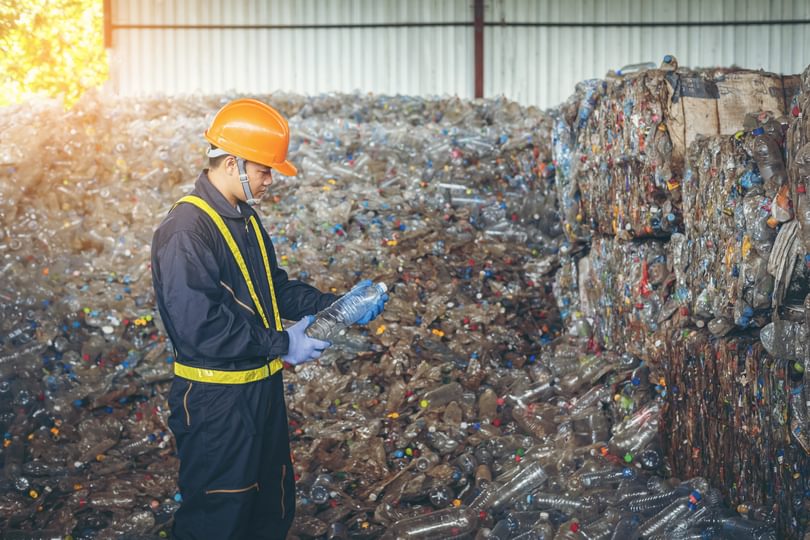
Nowadays, waste separation and recycling has become a routine act of our daily lives. Recycling bins are a common sight in many households, and in some places a government mandate. But when most people think about recycling plastics, they know little about the fate of their plastic waste.
We imagine milk jugs and fruit trays being melted down and turned into trainers or plastic bottles. This type of recycling process – called ‘physical’ or ‘mechanical’ recycling – is relatively expensive and energy intensive. More importantly, the presence of plastic mixtures or even minute amounts of additives in commercial products, in addition to the reprocessing treatment itself, downgrades the quality of the recycled plastic. This means that plastics recycled this way are not financially or physically adequate for many of the applications that brand new, ‘virgin’ plastics are used for. Because of this recycling still represents a small fraction of what happens to our plastic products at the end of their life.
The contamination of our oceans and rivers is one direct consequence of the lack of alternatives for managing plastic waste.
Not all plastics are even suitable for mechanical recycling. Only thermoplastics, that can flow when heated, can be remoulded into new shapes and products. Other very important plastics, like some of those found in cars and electronic devices, cannot be melted or reprocessed. In the best scenario, these materials are downcycled to less valuable products. More typically, they are burned or landfilled.
The contamination of our oceans, rivers, and coastal environments with microplastics is one direct consequence of the lack of alternatives for managing our plastic waste. We cannot solve all of our plastic problems by relying on this single avenue for recycling. This is why researchers around the world are actively investigating chemical pathways to recover the molecular building-blocks that made the plastics in the first place.
Plastics, or polymers, are made of many repeat units called monomers linked into long molecular chains, sometimes dozens or hundreds of units long. By breaking these molecular chains back into their links, ‘chemical’ recycling can turn polymers back into these monomers. Chemical recycling can also be applied to many materials not suitable for mechanical recycling. And the raw materials recovered in this way, are similar, if not identical, to what is used to create brand new plastics. In turn, plastics created with chemically recycled monomers are virtually indistinguishable from virgin plastics in both quality and application potential.
Closed-loop recycling could create a revolution in the perception of discarded plastics. What is now rubbish would become a resource.
Perhaps the most studied case of chemical recycling is that of polyethylene phthalate, or PET, a type of plastic used in soda bottles and medical blister packs. This type of polyester can be reacted with other small molecules in the presence of adequate catalysts during a process called “depolymerisation”. Recently, a chemistry team at the University of Oxford, lead by Professor Charlotte Williams, has discovered a different depolymerisation method for plastics derived from carbon dioxide (CO2), limonene oxide and decalactone, a series of bio-sourced and renewable monomers. These new polyester-polycarbonate thermoplastics materials are very elastic and show superior mechanical properties than some commercial polymers derived from other renewable sources. The researchers demonstrated that the polycarbonate units could be partially depolymerised back to CO2 and limonene oxide, the original building block molecules.
Adopted at scale, closed-loop recycling could create a revolution in how we, as consumers, and the chemical industry perceives our discarded plastics. What is now rubbish would become a resource, the building blocks to create more of the high quality, essential or desirable items that define our modern society. A truly circular path for plastics to be used and reused continuously with very little ending up in landfill or in our seas.
However, many scientific, technical and economic challenges remain. First and foremost, chemical recycling requires more energy than physical recycling since atomic bonds are broken and then reformed again. In turn, virgin oil-based plastics remain economically more competitive than recycled or bio-based plastics. Despite these limitations, small venture chemical companies are adopting circular processes of chemical recycling that will challenge our current “linear” mind-frame of create-consume-dispose in years to come.
The Future of Plastics programme at the Oxford Martin School is working on that part of it too. We are an interdisciplinary team of chemists, economists, and law-scholars working to find a holistic transition to a circular plastic economy. In this future, we maintain all the societal benefits brought by plastics, whilst ensuring that natural resources are preserved and that the environmental and health risks are minimised. We push for more investment in the research required, both in academic and industrial settings, for future discoveries and implementations towards truly circular plastics. At the same time, we call for new policies to incentivise the adoption of modern technologies and change societal habits.
On this Global Recycling Day we can all make a difference. The power is in all of us, consumers, producers, and policy makers, to contribute to a more sustainable and less wasteful future, for us and for the planet.
This opinion piece reflects the views of the author, and does not necessarily reflect the position of the Oxford Martin School or the University of Oxford. Any errors or omissions are those of the author.
